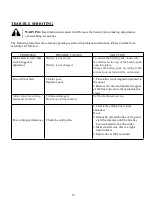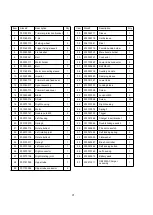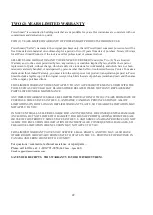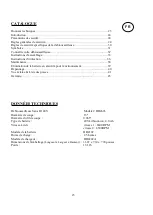
8
b) Disconnect the battery pack from the appliance before making any adjustments, changing accessories, or
storing appliance. Such preventive safety measures reduce the risk of starting the appliance accidentally.
c) Recharge only with the charger specified by the manufacturer. A charger that is suitable for one type of
battery pack may create a risk of fire when used with another battery pack.
d) Use appliances only with specifically designated battery packs. Use of any other battery packs may create a
risk of injury and fire.
e) When battery pack is not in use, keep it away from other metal objects, like paper clips, coins, keys, nails,
screws or other small metal objects, that can make a connection from one terminal to another. Shorting the
battery terminals together may cause burns or a fire.
f) Under abusive conditions, liquid may be ejected from the battery; avoid contact. If contact accidentally
occurs, flush with water. If liquid contacts eyes, additionally seek medical help. Liquid ejected from the
battery may cause irritation or burns. (This advice is considered correct for conventional NiMh, NiCd, lead
acid and lithium-ion cell types. If this advice is incorrect for a cell design that differs from these, then the
correct advice may be substituted.)
g) Do not use a battery pack or appliance that is damaged or modified. Damaged or modified batteries may
exhibit unpredictable behavior resulting in fire, explosion or risk of injury.
h) Do not expose a battery pack or appliance to fire or excessive temperature. Exposure to fire or temperature
above 130°C may cause explosion. The temperature of 130°C can be replaced by the temperature of 265°F.
i) Follow all charging instructions and do not charge the battery pack or appliance outside of the temperature
range specified in the instructions. Charging improperly or at temperatures outside of the specified range may
damage the battery and increase the risk of fire.
j) Have servicing performed by a qualified repair person using only identical replacement parts. This will
ensure that the safety of the product is maintained.
k) Do not modify or attempt to repair the appliance or the battery pack (as applicable) except as indicated in
the instructions for use and care.
Proper care for battery
Off-season storage
To obtain the longest possible battery life, we suggest the following:
Remove the battery pack from the charger once it is fully charged and ready for use.
For battery pack storage longer than 30 days:
Store the battery pack where the temperature is below 80°F and away from moisture.
Store battery packs in a fully charged condition.
Every two months of storage, charge the pack as normal.
Charger safety rules
Charge the battery in a dry area that is protected from the weather. Do not expose the string trimmer or the
charger to rain. Do not charge the battery in a wet location. Operate the battery charger in temperatures
between 45° and 104°F. In order to reduce the risk of electric shock, use only the charger that is provided
by the manufacturer to charge the battery.
DO NOT ABUSE THE CHARGE CORD. Never carry the charger by the cord. Do not disconnect the
charger from the outlet by pulling the charger cord.
Do not use a damaged charger. Replace the charger cords or the charger immediately.
Keep the string trimmer and the charger away from water, heat sources (radiators, heaters, stoves,etc.),
flames, and chemicals.
Make sure the battery pack is secured in the charger before beginning operation.
The battery pack will become slightly warm to the touch while charging. This is normal and does not
indicate a problem.
Do not place the charger and battery pack in an area of extreme heat or cold. They will work best at normal
room temperature.
Summary of Contents for DB2603
Page 2: ......
Page 20: ...20 EXPLODED VIEW PART LIST ...
Page 41: ...41 VUE ÉCLATÉE ...
Page 63: ...63 DESPIECE Y LISTA DE PIEZAS ...









































